|
|
Waldo Bien
cat pounces
The Rano Raraku on the island of Rapa Nuï is one of the most breathtaking volcanic craters in the world. There are many volcanic craters which can take the breath away, but for different reasons. Looking at the Rano Raraku - situated in the desolate solitude of the Pacific Ocean it takes our breath away to such an extent because we know that this is the birth-place of Moai’s Easter-Island sculptures. In a black-covered rubble surface rests, five hundred steps more to the north, at an altitude of 70 meters, a round eroded volcano. On the eastern side, coming down from the top, are screes descending in direct tracks to the foot of the mountain. These tracks owe their existence to a long forgotten festival, which involved the inhabitants sliding down the hill slopes on banana leaves.
Almost a hundred steps from the foot of this black and feminine-shaped hill one finds, half above and half below the ground, an umu-pae, surrounded by stones which once served as a cooking furnace. On the island there are umu-paes in pentagonal, right angled, and round forms, constructed with five, six or seven rectangular stones, placed in the ground. The umu-pae at the foot of the volcano has a pentagonal form, lying at my feet like the miniature of a walled monastic garden. In the exact middle of this small hortus conclusus grew a perfectly formed dandelion, where the prickly green leaves filled the five angled space perfectly without touching the stones anywhere.
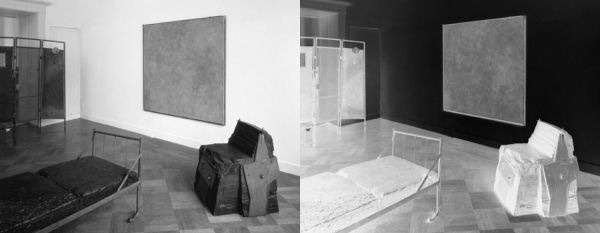 It was as if the plant’s growth had been halted within a centimeter of the fence and was prevented from touching the stones. Looked at from above the plant appeared as a pentagonal fixed in the centre by a well formed yellow flower, an upright, robust stalk stood out amply over the stones. One might think that the stone protection had aligned itself with the mathematical form of the plant. It was as if the plant’s growth had been halted within a centimeter of the fence and was prevented from touching the stones. Looked at from above the plant appeared as a pentagonal fixed in the centre by a well formed yellow flower, an upright, robust stalk stood out amply over the stones. One might think that the stone protection had aligned itself with the mathematical form of the plant.
I was curious about the roots of this plant which I had uprooted with effort. The roots seemed no less perfect than the plant. It was long and straight, a little shorter than the visible part of the plant. This part of the plant was like a satellite dish above the ground, gathering the light above the ground to let it penetrate the darkness of the earth. Simultaneously the root absorbs the darkness and transports it upwards, so that, in this weaving co-operation of both potentialities the color can appear. Just on the border where these cross currents flow, in the passage between root and plant, the root gets its first color and the plant also. The polar exchange takes place on the border of the root and the plant, a transitory area of symbolic life to symbolic death.
I am writing these words a few days before Christmas, the day when the birth of Jesus as Messaiah is celebrated, The Messaiah existed before the birth. The prophets in the Old Testament (not a bad thing) announced him as ‘the coming one’. From the moment his birth had dawned, he became a real being amongst us. But the ante-birth and the birth are one, in spite of that opposition between the body and spirit. The liberation is achieved through the Godman, there where body and spirit connect with each other. On the border of the root and the plant.
But now let us get away from roots and plants. Between photo-negatives and prints there is also a strange in-between, of connections and reversals. The moment of reversal itself. The moment this takes place in the developer we are unable to perceive it. We note the process only from the moment it has already begun, and on the photo paper the first vague impression, like a memory of the negative itself, appears as a counter-image. After a little massage of the brain convolutions, the photo-negative can be read easily as positive. It is simply a matter of exercise and experience, as anyone familiar with such material can confirm. Those whose symbiosis of intuition and perception has not been eroded by professional pragmatism, on entering this other inverted world have the feeling that they have entered a place not intended for us. Nevertheless these two worlds are equal, a=b b=a.
From such an insight one could conclude that we, without substantial loss, could turn all the colors in a opposition of Mondriaan round 180º, so that they become complimentary, and now the work appears to us in its negative.
 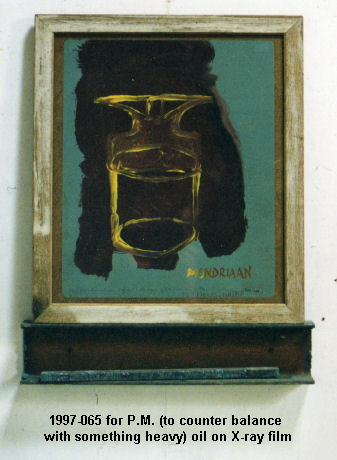 blue = orange blue = orange
red = green
yellow = violet
white = black
simplified
black _ white
white _ black
This evokes in us a strong aversion to seeing the so familiar Mondriaan thus distorted. Only the most hard-necked observer will finally have the pleasure to lean backwards in his chair, astonished but content. But what is so special about Mondriaan? Why has his work shocked the world so much? I think that Mondriaan shows us the contrary of what is actually meant for us to see, and which, without his activity, we would have been kept waiting a long time to become aware of. He draws part of the veil aside and gives us an undisturbed view of what is hidden for us behind the mirror. Whether Mondriaan is suitable for general consumption is a question of an other order, but for children under the age of seven he is taboo.
In sculpture we know another, and in a way comparable phenomenon: the German sculptor Wilhelm Lehmbruck [ 1881–1919 ]. Especially in his female figures he points our attention towards the invisible. In contrast to Mondriaan, who pulls the blinkers from our eyes and brutally forces us to see the other side of the mirror. Lehmbruck allows us to gain insight for what is, in viewing his sculpture, where we can develop our view of the other side of the mirror, namely the cultivation of observation from the visible to understand and know the invisible. You don’t have to, as Mondriaan and I did uproot the plant to see and understand the roots. After I had dug it out, I did not put the plant back in the ground. There was no reason to. It had grown and bloomed. Maybe Mondriaan had thought the same. With Lehmbruck we have to look less at the sculptures and more towards their surroundings, the ‘forming’ world around it.
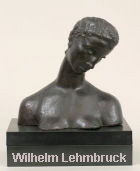 It seems that Mondriaan has searched all his life and that Lehmbruck knew all his life. The dissection and reduction method of Mondriaan delivers a product in which the cut of the knife is significant. Lehmbruck’s conceptions are developed with the help of the forming hand itself. Maybe it is important to know that Lehmbruck was the son of a coal miner. It seems that Mondriaan has searched all his life and that Lehmbruck knew all his life. The dissection and reduction method of Mondriaan delivers a product in which the cut of the knife is significant. Lehmbruck’s conceptions are developed with the help of the forming hand itself. Maybe it is important to know that Lehmbruck was the son of a coal miner.
In mining there are, as in many other professions, different hierarchical ladders. To which group you might eventually have access is dominated by the topographical position of the work place. Über oder unter Tage it is called in German and Above or below the Ground, Boven of Onder de Grond, in Dutch. In German the expression has to do with light, and in Dutch with real estate.
In principle there are two polar brotherhoods: the ‘Black’ and the ‘White Brothers’, but there also exists a brotherhood of borderline brothers, the so called ‘Greys’. Their knowledge and energy is directed towards the conservation of dialogical thinking below ground. The membership of the ‘Black Brothers’ can only be gained if you earn your daily bread in the dust of the darkness; it has several initiation procedures and rituals. One of the most significant rites of passage penetrates consciousness as the crossing over the boundary from day-light to earth-darkness, and from day-darkness to light-earth (the plant). Another initiation contains the consciousness of the light source of the carbon darkness, and the insight, that finally at the end and the insight that with enough pressure of time - and also here the announcement by geoprophets - the diamond will be born as Messaiah to liberate the carbon plant from its suffering. Lehmbruck had almost certainly known or heard about such things, or had a kind of ancestral knowledge, in German geahnt, which in Dutch is characterized as Vermoed, and the noun Ahnenschaft suggests this intuitive ‘ancestral’ surmise.
As far as Mondriaan is concerned: it is remarkable that the very work which is the hinge of his œuvre was not included in the general retrospective show in the Hague’s Gemeentemuseum, but was hanging a floor below in the permanent collection - as if it had become reduced in circumstances. On page 390 of the extensive catalogue it is reproduced in black and white and not given any prominence. The triptych was painted 1910/11, and has as its title Evolution. On every part of the triptych there is, through theosophically clouded spectacles, an art-deco female figure depicted. Mondriaan has, as we know, for certain period cherished theosophical ideas. But this period continued longer than a wandering day, as some would have us believe, because ten years later, right during the Stijl phase, he wrote to the theo- and anthroposoph Rudolf Steiner. He communicates his opinions about the Nieuwe Beelding and seeks Steiner’s endorsement. The oracle didn’t reply. The triptych is regarded as ‘non-significant theosophical wandering’ and the curators of the retrospective exhibition must have shared this view.
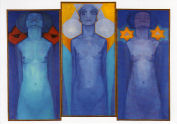 Thematically and stylistically the works of Mondriaan before Evolution responded to his living surroundings. Suddenly, we see, how this living and moving begins to freeze dramatically in the three female figures in Evolution and they are hardened and stiffened. This is exactly the opposite of what happens in the sculptures of Lehmbruck, who determines the body, as the solidification of the higher, the spiritual, and in his sculptures he attempts to disentangle and dissolve it into the etherical. In the further development of his life Mondriaan did not wish to liberate himself from these three painted creatures. The ghost is in the machine for ever. Also in the case of Mondriaan. Then he shows us what he has understood through them. Thematically and stylistically the works of Mondriaan before Evolution responded to his living surroundings. Suddenly, we see, how this living and moving begins to freeze dramatically in the three female figures in Evolution and they are hardened and stiffened. This is exactly the opposite of what happens in the sculptures of Lehmbruck, who determines the body, as the solidification of the higher, the spiritual, and in his sculptures he attempts to disentangle and dissolve it into the etherical. In the further development of his life Mondriaan did not wish to liberate himself from these three painted creatures. The ghost is in the machine for ever. Also in the case of Mondriaan. Then he shows us what he has understood through them.
With his well-practiced hand he writes to Steiner to report that he has unveiled the theosophical secret, and in the three female figures he has recognized the primary colors. Evolution the ‘insignificant painting’ is the focus of the lens in which he moves from one world into its counter. For someone like Mondriaan, who has shown us explicitly his involvement with nature, this must surely have been a crucial moment. He exchanges feeling for ratio. Such a thing a painter doesn’t do sitting in a closet, but he takes a canvas and becomes active.
According to his theosophical insight Mondriaan uses three canvases for this. There is a turning over process from one œuvre to another, by which something dies and from which something else is born, happening in this work. In the triptych the central panel is a little larger than the two side panels. Mondriaan fixes the turning moment in the middle panel, on the border of the root and the plant, at the moment which in the photo-development process we know is not perceivable to 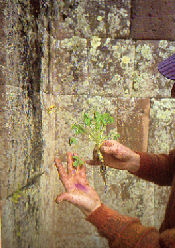 the eye. The dying off and transformation is found in the central panel. This is the tombstone of what died in Mondriaan’s insight. This allows us to look at the work of Mondriaan with more compassion, to approach it as a monument of a tremendous moment. the eye. The dying off and transformation is found in the central panel. This is the tombstone of what died in Mondriaan’s insight. This allows us to look at the work of Mondriaan with more compassion, to approach it as a monument of a tremendous moment.
The women seem hewn out of stone. The bodies forced in crystal shapes with a broad flat chisel. Salt crystal, skeleton, crystal skeleton, descending from the earth floating in astral blue.
As to Mondriaan’s further development we can read it in geomorphology books. The magma fully solidifies, there is crystallization and fragmentation into smaller and smaller parts. Victory Boogie Woogie 1942/47 and finally earth again. In this earth Mondriaan is finally interred on 3 February 1944 in New York. In fact he died that day for the second time.
Someone who is familiar with New York typography would come to the conclusion that Mondriaan was buried in his last painting. He had worked on Victory Boogie Woogie just some days before his decease. The square balancing on a corner angle. There Mondriaan takes on a deep burden, this deadly fixation of axial and radial forces. Salt crystal, skeleton, crystal skeleton. That’s what he died of. On the next corner of the street the monochromes were waiting for him, but he didn’t make it to that corner. On the 3 February 1944, he reached the point where the motor of the Boogie Woogie is stopped. Only one question remains: did the cat finally catch the mouse, or not?
|
|